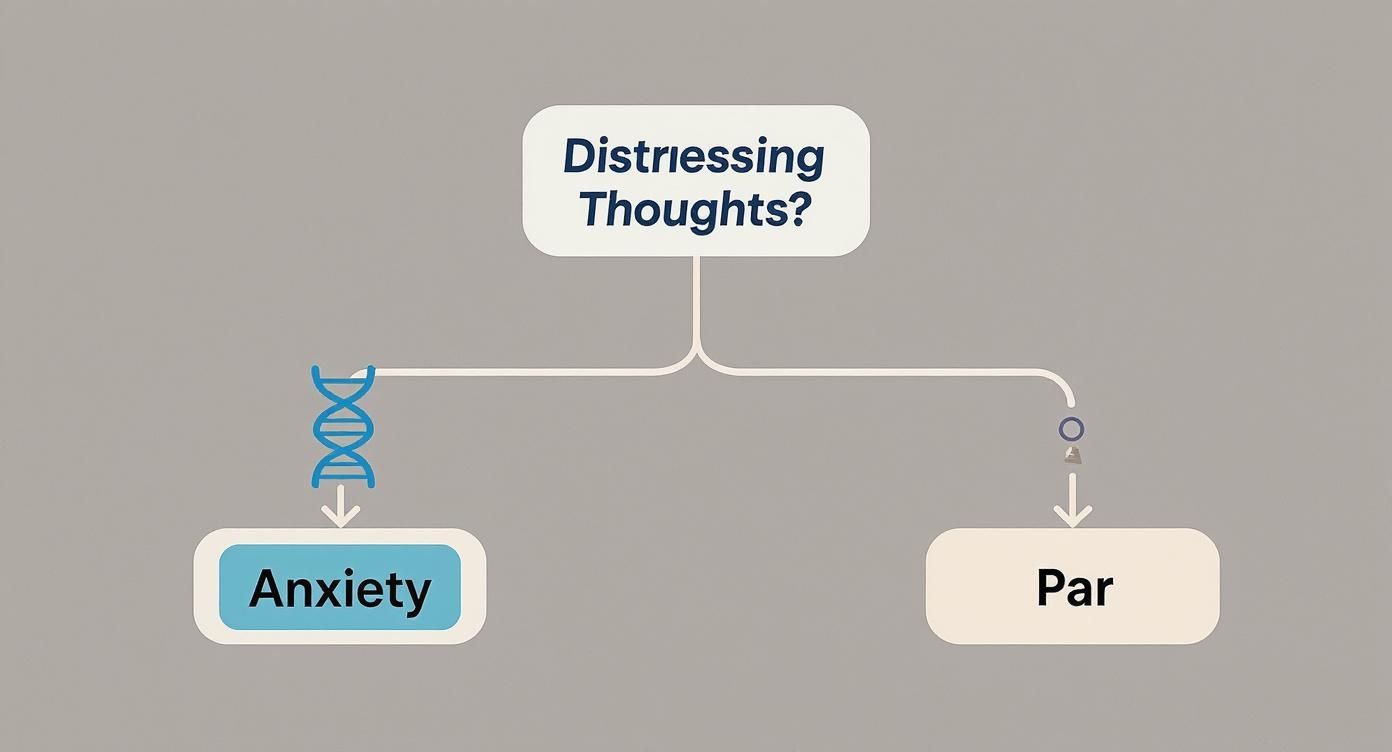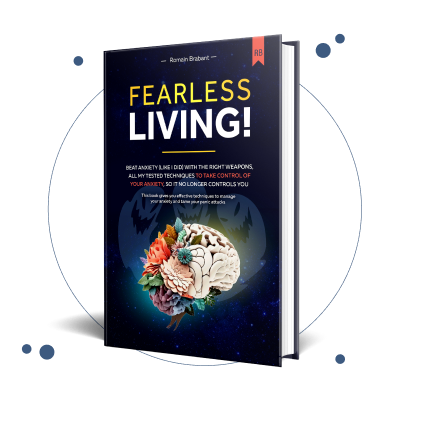
When your mind is racing, it’s easy to feel lost. But there's a world of difference between feeling anxious and feeling paranoid, and figuring out which is which is the first real step toward feeling in control again. Healing is possible, and a life free from panic is within your reach.
Here’s the simplest way I can put it: Anxiety is a persistent fear of 'what if'—a constant worry about all the things that might go wrong in the future. In sharp contrast, paranoia is a firm belief in 'what is'—a conviction that you are in immediate danger or being targeted right now, often without concrete proof.

Untangling Anxiety and Paranoia
Feeling overwhelmed by intense worry or suspicion can be incredibly isolating. The first thing to know is you’re not alone, and finding your way back to feeling safe is entirely possible. The journey just starts with gently untangling what you're actually experiencing.
Think of it this way: Anxiety puts you on edge about potential threats down the road. Paranoia makes you feel actively targeted by a very real, very present danger. This one core difference changes everything—from the nature of your thoughts to your body’s response.
Recognizing these patterns isn’t about slapping a label on yourself. It's about gaining the self-awareness you need to heal. Millions of people learn to manage these feelings successfully. This understanding is what empowers you to find the right kind of support, validating that what you feel is real, treatable, and not a life sentence. A calm, panic-free life is a realistic goal.
The Core Difference at a Glance
Sometimes, seeing things laid out side-by-side just makes it all click. This table breaks down the fundamental thought patterns behind anxiety and paranoia, helping to demystify these confusing experiences.
Core Differences Between Anxious and Paranoid Thoughts
| Feature | Anxiety | Paranoia |
|---|---|---|
| Nature of Fear | Generalized worry about various "what if" scenarios (e.g., job loss, health). | Specific, fixed belief of being persecuted or harmed by others. |
| Focus of Threat | The threat is seen as a potential future event. | The threat is believed to be happening now and is intentional. |
| Thought Process | Characterized by excessive, looping worries that can often be recognized as irrational. | Characterized by delusional or deeply suspicious beliefs that feel entirely real. |
| Evidence Basis | Fear may be disproportionate to the situation, but is often linked to plausible concerns. | Beliefs are held firmly, even with little to no supporting evidence or contrary proof. |
This at-a-glance view helps clarify where your thoughts might be landing on the spectrum. It’s a crucial distinction because the path forward for each looks very different.
Here's the most hopeful truth in all of this: Whether your thoughts are rooted in anxiety or lean toward paranoia, both are understood and manageable with the right tools. Your experience does not define you. Healing is a realistic, achievable goal.
This knowledge is your starting point. Many types of anxiety disorders exist, each with its own quirks, but they all share common pathways to getting better. By identifying the specific nature of your fears, you can start using targeted strategies that lead to lasting relief and a life with less panic.
A Nuanced Comparison of Symptoms
To really get the difference between anxiety and paranoia, we need to go deeper than just dictionary definitions. It's about looking at how they actually feel, day in and day out. The internal monologue, the physical sensations, and the urges you feel are different in subtle but really important ways.
Learning to spot these nuances in your own experience is a huge act of self-compassion. It's the first real step toward finding relief. Think of it as seeing these patterns not as personal flaws, but as signals your mind and body are sending you. Once you have that clarity, you can start navigating your feelings with more confidence, knowing a path to a calmer life is absolutely possible.
The Nature of Threat Perception
The real heart of the difference between anxiety and paranoia is how you see a threat. Anxious thoughts are all about the future and what might happen. Paranoid thoughts, on the other hand, are about the present and feel like absolute certainties.
Let’s use a real-world example. Say you have a performance review coming up at work.
- Anxious Thought: "What if my boss hated my presentation? I could get a terrible review and even lose my job. I should have worked on it more." This is a classic "what-if" spiral, full of self-doubt and fear about a potential bad outcome.
- Paranoid Thought: "My boss is trying to get me fired. I saw her talking to HR, and I just know they're putting together a case against me. Every email she sends is a trap." This isn't a question; it's a statement of fact—a firm belief in an active, malicious plot.
Anxiety has you worrying about what could go wrong. Paranoia convinces you that something is going wrong right now, and someone else is pulling the strings. This distinction changes everything about how you experience your reality.
The Role of Evidence
Another key difference is how you handle evidence—or the lack of it. Anxiety tends to grab onto tiny, ambiguous bits of information and blow them way out of proportion. It's a thinking pattern that often involves common cognitive distortions that twist your perception of reality.
Paranoia, however, doesn't really need evidence. In fact, it often sees the absence of clear evidence as proof of an even more cunning conspiracy.
Key Insight: Anxiety asks, "What if I'm misreading the signs?" Paranoia concludes, "The lack of obvious signs proves how secretly they are working against me."
Take this scenario: you text a friend, and they don’t reply for a few hours.
- Anxiety: "Did I say something offensive? Are they mad at me? Maybe they're just busy… but what if they're ignoring me?" The anxious mind races through possibilities, usually fixating on the worst one.
- Paranoia: "They are deliberately ignoring me to make a point. They're probably showing our texts to our other friends right now, turning everyone against me." The paranoid mind assumes malicious intent and betrayal without needing any proof at all.
Physical and Emotional Sensations
The way these states show up in your body also gives us important clues. While both feel intensely uncomfortable, the physical experience is different. Anxiety is known for triggering the classic fight-or-flight response.
Physical Symptoms of Anxiety:
- Sudden surges of adrenaline.
- A pounding heart or palpitations.
- Shortness of breath or feeling like you're choking.
- Dizziness and trembling.
- Sweating and a nervous stomach.
These symptoms often hit in waves, like a panic attack. It’s your body’s alarm system blaring about a potential future threat. It's exhausting, but it's often episodic.
Paranoia, on the other hand, puts you in a state of sustained hypervigilance. It’s less like a sudden alarm and more like a constant, low-grade state of emergency.
Physical and Emotional State in Paranoia:
- Persistent muscle tension, especially in your shoulders, neck, and jaw.
- Constantly scanning your surroundings for threats or signs of betrayal.
- An inability to truly relax because you feel you must always be on guard.
- A deep, pervasive sense of mistrust and suspicion toward others.
- Emotional withdrawal and isolation as a way to protect yourself.
This isn't just feeling "on edge." It's a bone-deep belief that you are unsafe and must stay vigilant to survive. This constant state of alert is incredibly draining and can lead to chronic fatigue and social isolation. By paying close attention to your own physical and emotional cues, you can gain powerful insight into what you're truly experiencing—and that's the first step toward finding the right way to heal.
Where Do These Feelings Come From?
Trying to figure out where intense worry or suspicion comes from is a huge part of feeling better. These experiences don't just pop up out of nowhere. They're usually rooted in a complex mix of your genetics, brain chemistry, and the things you’ve been through.
Getting to the "why" behind your thoughts isn’t about placing blame—it's about understanding. It reinforces the truth that this isn't your fault, which opens the door to self-compassion and a real path forward.
Neither anxiety nor paranoia is a sign of weakness. Think of them as understandable responses to a combination of internal and external pressures. By digging into their origins, we can shift from self-criticism to real, hope-filled solutions.
The Biological Blueprint for Anxiety
For a lot of people, a tendency toward anxiety is literally woven into their biology. Genetics play a pretty big role, which means if anxiety runs in your family, you might be more susceptible yourself. This doesn't seal your fate, but it can make your nervous system a bit more sensitive to stress.
Brain chemistry is another key piece of the puzzle. An imbalance in neurotransmitters like serotonin and dopamine—the chemicals that regulate mood and fear—can lay the groundwork for chronic worry. This is why long-term, intense stress can feel like it's physically rewiring your brain. In a way, it is. Your brain learns to default to a state of high alert.
But here’s the good news: that's not a permanent state. Your brain has this incredible ability called neuroplasticity, which means it can change and form new, healthier pathways. Through targeted therapies and lifestyle shifts, you can absolutely learn to manage these biological tendencies and live a life free from panic.
Hopeful Takeaway: Your brain is built to adapt. Even if you're biologically wired for anxiety, you have the power to retrain its responses and build resilience. Your biology doesn't get the final say.
Life Experiences That Shape Fear and Mistrust
While biology might set the stage, our life experiences often write the script. Both anxiety and paranoia are frequently tied to specific things in our environment and personal history. These experiences can leave a lasting mark on how we see threats and decide who to trust.
Common Triggers and Risk Factors:
- Prolonged Stress: Juggling a high-pressure job, dealing with financial strain, or caring for a loved one can completely drain your coping resources, leaving you vulnerable to constant anxiety.
- Significant Life Changes: Things like a big move, a tough breakup, or losing someone you love can shake your sense of security and kickstart anxious thought patterns.
- Traumatic Events: Experiencing or witnessing trauma can hardwire the brain for hypervigilance. When the world no longer feels safe, it can fuel both intense anxiety about what’s next and paranoid beliefs about current dangers.
- Social Isolation or Betrayal: This one is big for paranoia. Experiences of deep betrayal, social rejection, or chronic loneliness can breed a powerful sense of mistrust. When people you were supposed to be able to count on hurt you, it’s a natural defense to become suspicious of everyone else’s intentions.
Globally, anxiety is incredibly common. It’s actually the most prevalent mental health condition, affecting an estimated 301 million people worldwide. If you're struggling, that number should tell you that you are far from alone in this.
Diving into the common anxiety causes can be the first step in making sense of your own story. For more on these statistics, recent reports from SingleCare offer some powerful insights. Recognizing these roots isn't about getting stuck in the past; it's about validating your feelings so you can start healing the wounds that fuel them.
How Professionals Diagnose and Differentiate
Deciding to get help for distressing thoughts is a huge, hopeful first step. It's also normal to feel a little intimidated by the process. Knowing how clinicians tell the difference between anxiety and paranoia can take some of the mystery out of it, making the whole thing feel more manageable. Professionals use a careful, structured approach to get to an accurate diagnosis, which is really the foundation for finding a treatment that actually works.
A mental health professional’s main goal is to understand exactly what you're experiencing, from your point of view. They’ll likely ask you detailed questions about your thoughts—what they’re like, how often they show up, and how intense they feel. Think of it less like an interrogation and more like a collaborative effort to map out your inner world.
This flowchart shows a simplified path of how different starting points can lead to either anxiety or paranoia.

As the diagram illustrates, factors like genetics can often be a piece of the anxiety puzzle, while major life events might be a pathway toward paranoia.
The Diagnostic Framework
Clinicians often use the DSM-5 (Diagnostic and Statistical Manual of Mental Disorders) to guide their assessment. This isn't about slapping on a label; it’s a tool with clear criteria that helps them sort through conditions with overlapping symptoms. The key is to figure out the core belief system that’s fueling the distress.
A professional will want to know if your fear is rooted in future possibilities (“what if?”) or a firm, present-tense conviction (“I know this is real”). To get at this, they might ask things like:
- "When you feel this way, are you worried something might happen, or do you believe you’re in danger right now?"
- "Can you think of any evidence that goes against these beliefs?"
- "How do other people react when you share these worries with them?"
These kinds of questions help untangle the generalized worry of an anxiety disorder from the fixed, often persecutory beliefs that come with paranoia. Knowing how to find the right psychiatrist for anxiety is a critical part of this, as it ensures you're working with someone skilled in making these subtle but important distinctions.
A diagnosis isn't meant to label you—it's meant to unlock the right path to healing. Getting it right is a moment of clarity that points directly to the therapies and strategies that can truly help you live a life with less panic.
Context and Belief Systems
Another key piece of the diagnostic puzzle is how rigid your belief system is. Someone with anxiety can usually, even if just for a moment, acknowledge that their fears might be over the top or irrational. There's a part of their mind that can still question the worry.
Paranoia is different. It involves beliefs held with an unshakeable conviction, even when there's clear evidence to the contrary. This is a crucial distinction. While paranoid thoughts are surprisingly common—one study found that around 25% of people have them regularly—it’s their persistence and impact on daily life that matter for a diagnosis.
Even major societal events can trigger widespread paranoid-like thinking. After the 2001 anthrax attacks, for example, fear led to real, psychosomatic symptoms in many people who were never exposed. A professional’s job is to determine whether these thoughts are fleeting suspicions or part of a more structured delusional system that would require a very different approach to treatment.
Actionable Pathways to Healing and Hope
Recovery isn’t just some far-off possibility—it’s what we expect to happen when you find the right support. Walking the path from fear to freedom can feel overwhelming, but it’s a journey you don’t have to take alone. With proven strategies and a real commitment to self-compassion, you can build a life defined by confidence, not by anxious or paranoid thoughts.

This journey starts with one crucial understanding: both anxiety and paranoia are treatable. Effective clinical therapies and practical self-help techniques are out there, ready to help you reclaim your peace of mind. The trick is finding the right combination that works for you, giving you the skills to manage these feelings and build lasting resilience.
Evidence-Based Clinical Treatments
Professional guidance creates a structured, safe space to explore your thoughts and develop new ways of coping. Therapies are carefully chosen to address the unique challenges of anxiety versus paranoia, making sure the approach gets to the root of the distress.
A cornerstone of treatment for anxiety is Cognitive Behavioral Therapy (CBT). This is a practical, goal-oriented therapy that helps you identify, challenge, and reframe the negative thought cycles that fuel your worry. A therapist works with you to dismantle the constant "what if" thinking and replace it with more balanced, realistic perspectives.
For paranoia, the therapeutic approach is more specialized. While CBT can still play a role, treatment often starts with building a strong, trusting relationship with the therapist. From there, the goal is to gently test the reality of suspicious beliefs in a safe setting and build stronger critical thinking skills to evaluate perceived threats. Antipsychotic medications may also be prescribed to help dial down the intensity of delusional thoughts.
Hopeful truth: You are not your thoughts. Therapy provides the tools to step back, observe your thought patterns without judgment, and choose how you respond. This separation is where your power and freedom lie.
Understanding the different options for psychotherapy for anxiety can help you feel more prepared and confident when you decide to seek professional help. Each approach offers a unique pathway to understanding yourself and healing.
The table below breaks down how different therapeutic approaches are adapted for anxiety and paranoia, highlighting the distinct goals for each.
Comparing Treatment Strategies
| Treatment Type | Focus for Anxiety | Focus for Paranoia | Primary Goal |
|---|---|---|---|
| Cognitive Behavioral Therapy (CBT) | Identifying and reframing catastrophic "what if" thoughts. | Gently questioning the evidence for suspicious beliefs. | Develop more balanced, realistic thinking patterns. |
| Building the Therapeutic Alliance | Creating a safe space to explore vulnerabilities. | Establishing a foundation of trust before challenging beliefs. | Foster a secure environment for therapeutic work. |
| Reality Testing | Differentiating between likely and unlikely outcomes. | Evaluating perceived threats against objective evidence. | Strengthen the ability to distinguish thought from fact. |
| Medication | SSRIs or anti-anxiety medications to manage symptoms. | Antipsychotic medications to reduce delusional thinking. | Stabilize brain chemistry to support therapeutic progress. |
Ultimately, the right treatment plan is tailored to the individual, addressing the specific thought patterns and emotional distress at the heart of the issue.
Self-Help Strategies for Daily Empowerment
Alongside clinical treatment, there are powerful techniques you can start using today to manage your symptoms and build a foundation of calm. These strategies help ground you in the present moment, dialing down the power that future worries or present suspicions have over you.
Mindful Grounding Techniques: When your mind starts to spiral, grounding exercises can pull you back to the here and now. The 5-4-3-2-1 method is a simple but incredibly effective tool:
- Name 5 things you can see.
- Acknowledge 4 things you can feel.
- Listen for 3 things you can hear.
- Identify 2 things you can smell.
- Name 1 thing you can taste.
This sensory focus interrupts the loop of anxious or paranoid thoughts by anchoring you firmly in your immediate environment.
Journaling for Clarity: Writing your thoughts down is a surprisingly powerful way to get a handle on them. A journal can help you:
- Identify Triggers: Note when anxious or paranoid feelings pop up to spot patterns related to specific situations, people, or even times of day.
- Challenge Beliefs: Once a thought is on paper, you can question it more objectively. Ask yourself, "What evidence do I actually have for this? Is there another way to look at this?"
- Track Progress: Seeing how far you’ve come is a huge motivator. Your journal becomes a record of your resilience and growth.
Creative Outlets for Stress Relief: Getting into creative activities can be incredibly therapeutic. They offer a non-verbal way to process emotions and calm a racing mind. Many people find that using colouring books for anxiety is an accessible way to focus their attention and reduce stress.
By combining professional support with these daily practices, you create a solid toolkit for managing your mental health. Every small step you take is a victory, moving you closer to a life where you are in control. Healing is an active process of building new habits and thought patterns, and it is entirely within your reach.
Common Questions About Anxiety and Paranoia
It’s completely normal to have questions when you’re trying to make sense of intense emotions. Let's clear up a few of the most common worries people have when navigating the line between anxiety and paranoia. Getting clear answers is a sign of strength, and every question you ask is a step toward feeling more in control.
Can Severe Anxiety Lead to Paranoia?
This is a big one. It's a common fear that intense, spiraling anxiety might eventually flip a switch and become clinical paranoia.
While they can definitely feel related—and even overlap during moments of extreme stress—anxiety does not typically transform into paranoia. The fundamental difference holds true: anxiety is rooted in the fear of what might happen, while paranoia is a firm belief that something harmful is happening right now.
That said, living with chronic, severe anxiety puts your entire nervous system on high alert. When you're constantly hypervigilant, your brain is wired to spot threats everywhere. This can absolutely make you feel more suspicious or mistrustful, creating a mental environment where paranoid-like thoughts might occasionally pop up.
This is exactly why getting professional support for severe anxiety is so important. It isn’t just about managing the anxiety itself; it’s about preventing your symptoms from escalating and helping you stay grounded in reality. Taking action is one of the best ways to protect your long-term mental health.
What Is the First Step If I Suspect Paranoia?
If you’re worried your thoughts are shifting from anxious to paranoid, the single most powerful and courageous thing you can do is reach out to a trusted healthcare professional. This could be your primary doctor or a mental health specialist. Their job is to provide non-judgmental support and expert guidance in a completely confidential space.
Taking this step allows a professional to:
- Rule out any underlying medical issues that could be contributing to your symptoms.
- Conduct a thorough, compassionate assessment of what you’re experiencing.
- Connect you with the right specialists and evidence-based treatments.
Reaching out for a professional opinion isn't a sign of weakness—it's an act of profound strength and self-care. It’s the clearest, most hopeful step you can take to understand what’s going on and get on a real path to feeling better.
That first conversation opens the door to effective strategies and support systems designed to help you get back your sense of safety and control. You don’t have to figure this out on your own.
How Can I Tell the Difference in My Own Thoughts?
Learning to observe your thoughts without getting swept away by them is a game-changer. It helps you become an impartial witness to your mind instead of a victim of its patterns. A simple but incredibly effective practice is to pause and gently question the nature of a distressing thought the moment it appears.
Ask yourself one key question: "Am I worried about something that might happen, or do I believe I'm in danger right now?"
Anxious thoughts are often future-focused and sound like a question. They usually start with "What if…?" For example, "What if I get fired for that mistake I made?"
Paranoid thoughts, on the other hand, feel like a present-tense certainty. They sound like a declaration. For instance, "I know my coworkers are plotting to get me fired."
Keeping a journal can be a huge help here. When you write down distressing thoughts, you create a little bit of distance, allowing you to analyze them more clearly. This practice not only reveals patterns over time but also gives you concrete information to share with a therapist, which can make your work together even more effective.
At The Anxiety Checklist, we believe understanding your thoughts is the first step toward mastering them. Our program, Fearless Living, provides a structured, actionable system to help you differentiate between thought patterns, challenge negative beliefs, and build a personalized toolkit for lasting mental wellness. Discover how to regain control and live a more fearless life by exploring The Anxiety Checklist.

